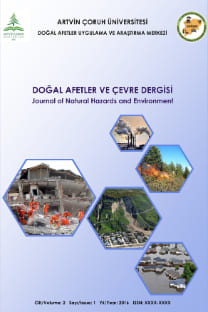Kocaeli İli Körfez İlçesi Konut Kaynaklı CO ve NOx Emisyon Dağılımlarının Farklı Modeller Yardımıyla Değerlendirilmesi
Evaluating Dispersion of Residential CO and NOx Emissions with the Help of Different Models in Körfez District, Kocaeli Province
___
Abdul-Wahab S., Sappurd A., Al-Damkhi A., (2011), Application of California Puff (CALPUFF) model: a case study for Oman, Clean Techn Environ Policy.Botlaguduru V.S.V., (2009), Comparison of AERMOD and ISCST3 Models for Particulate Emissions from Ground Level Sources, Master of Science, Texas A&M University, Texas USA.
Demirarslan K.O., (2012), Kocaeli İli Körfez İlçesi’nde Hava Kirletici Kaynaklarının ve Hava Kalitesi Seviyesinin Belirlenmesi, Kocaeli Üniversitesi, Fen Bilimleri Enstitüsü Doktora Tezi, Kocaeli.
Demirarslan K.O., (2015), Hava Kalitesi ve Değerlendirmesinde Modelleme Yaklaşımı, VII. Uluslararası Katılımlı Atmosfer Bilimleri Sempozyumu, 28-30 Nisan, İstanbul Teknik Üniversitesi, İstanbul.
Dölek E., (2007), Comparison of ISCST3 and AERMOD Air Dispersion Models: Case Study of Cayirhan Hermal Power Plant, Yüksek Lisans Tezi, ODTÜ, Yüksek Lisans Tezi, Ankara.
Elbir T., (2003), Comparison of model predictions with the data of an urban air quality monitoring network in Izmir, Atmospheric Environment, 37(15), 2149-2157.
EPA, (2012), United States Environmental Protection Agency (EPA) Technology Transfer Network Support Center for Regulatory Atmospheric Modeling, http://www.epa.gov/ttn/scram/dispersion_prefrec.htm, [Erişim 21 Temmuz 2012].
EPA, (2013), Dispersion Modeling, United States Environmental Protection Agency (EPA) Air Quality Management Online Portal http://www.epa.gov/oaqps001/aqmportal/management/modeling/dispersion.htm, [Erişim 1 Haziran 2013].
Korsakissok I., Mallet V., (2009) “Comparative Study of Gaussian Dispersion Formulae Within The Polyphemus Platform: Evaluation with Prairie Grass and Kincaid Experiments”, American Meteorological Society, 48, 2459–2473.
Laffoon C., Rinaudo J., Soule R., Bowie T., Meyers C., Madura R. L., Pakunpanya S. P., (2011), Developing State-Wide Modeling Guidance for the Use of AERMOD – A Workgroup’s Experience, http://files.abstractsonline.com, [Erişim 7 Nisan 2011].
Masuraha A., (2006). Evaluation of the AERMOD Model and Examination of Required Length of Meteorological Data for Computing Concentrations in Urban Areas, Master of Science in Civil Engineering, The University of Toledo, Spain.
Orloff G.K., Kaplan B., Kowalski P., (2006), Hydrogen Cyanide in Ambient Air Near a Gold Heap Leach Field: Measured vs. Modeled Concenrations, Atmospheric Environment, 40, 3022-3029.
Perry S.G., Cimorelli A.J., Paine R.J., Brode R.W., Weil J.C., Venkatram A.,Wilson R.B., Lee R.F., Peters W.D., (2005) AERMOD: A Dispersion Model for Industrial Source Applications.Part II: Model Performance against 17 Field Study, Databases Journal of Applied Meteorology, 44, 694-708.
Schroeder A.J., (2004), Comparison of Two Dispersion Models: A Bulk Petroleum Storage Terminal Case Study, Air & Waste Management Assoc.’s 97th Annual Conference and Exhibition, Indianapolis, USA, June 22–25.
Scire S.J., Strimaitis D.G., Yamartino R.J., (2000), A User’s Guide for The Calpuff Dispersion Model, 3th ed., Earth Tech Inc., Concord.
URL-1, (2009), www.scorecard.org, [Erişim 13 Mart 2009].
URL-2, (2013), http://scorecard.goodguide.com/env-releases/def/air_source.html, [Erişim 1 Haziran 2013].
URL-3, (2013), http://maps.google.com, [Erişim 6 Eylül 2013].
URL-4, (2010), http://www.weblakes.com/products/calpuff, [Erişim 30 Ocak 2010].
URL-5, (2012), ISCST-3 Tech Guide, http://www.weblakes.com, [Erişim 23 Şubat 2012].
URL-6, (2012), http://www.portmetrovancouver.com, [Erişim 21 Temmuz 2012].
Wolterbeek B., (2002), Biomonitoring of trace element air pollution: principles, possibilities and perspectives, Environmental Pollution, 120, 11–21.
Yılmaz N., Güven H., Şenkaya M., Şafak H., Artut S., Uzunkaya D., Pekeroğlu Ş., (2008), Kocaeli Valiliği İl Çevre ve Orman Müdürlüğü Kocaeli İl Çevre Durum Raporu, http://cdr.cevre.gov.tr/icd_raporlari/kocaeliicd2008.pdf, [Erişim 21 Temmuz 2012].
- ISSN: 2528-9640
- Yayın Aralığı: 2
- Başlangıç: 2015
- Yayıncı: Artvin Çoruh Üniversitesi Doğal Afetler Uygulama ve Araştırma Merkezi
SELÇUK ALEMDAĞ, ZÜLFÜ GÜROCAK, Ceren ÖZKİRİŞÇİ OKTAY
HALİL AKINCI, AYŞE YAVUZ ÖZALP, SEBAHAT TEMUÇİN KILIÇER
Mehmet ÖZALP, Ferit DEHŞET, BÜLENT TURGUT, SAİM YILDIRIMER, Eren İNANLI
Fitoremediasyon Yöntemi İle Topraktaki Ağır Metallerin Giderimi
MUSTAFA AYBAR, AYLA BİLGİN, BÜLENT SAĞLAM
MUSTAFA ZEYBEK, İSMAİL ŞANLIOĞLU, AŞIR GENÇ
Afet Yönetiminde Etik Sorunlar
Afet Planlamasında Deprem Riski Belirsizliklerinin Değerlendirilmesi
YASİN FAHJAN, FERHAT PAKDAMAR, YAŞASIN ERYILMAZ, F İlknur KARA
